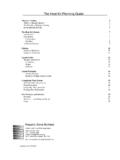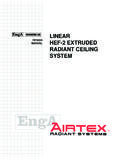Transcription of Compartment Fires - Masonry Stove Builders
1 11 Compartment IntroductionThe subject of Compartment Fires embraces the full essence of fire growth. The Compartment here can represent any confined space that controls the ultimate airsupply and thermal environment of the fire . These factors control the spread and growthof the fire , its maximum burning rate and its duration. Although simple room config-urations will be the limit of this chapter, extensions can be made to other applications,such as tunnel, mine and underground Fires . Spread between compartments will not beaddressed, but are within the scope of the state-of-the-art.
2 A more extensive treatment ofenclosure Fires can be found in the book by Karlsson and Quintiere [1]. Here theemphasis will be on concepts, the interaction of phenomena through the conservationequations, and useful empirical formulas and correlations. Both thermal and oxygen-limiting feedback processes can affect fire in a Compartment . In the course of fire safetydesign or fire investigation in buildings, all of these effects, along with fire growthcharacteristics of the fuel, must be understood. The ability to express the relevant physicsin approximate mathematics is essential to be able to focus on the key elements in aparticular situation.
3 In fire investigation analyses, this process is useful to develop, first, aqualitative description and then an estimated time-line of events. In design analyses, thebehavior of fire growth determines life safety issues, and the temperature and duration ofthe fire controls the structural fire protection needs. While such design analysis is notaddressed in current prescriptive regulations, performance codes are evolving in thisdirection. The SFPEG uide to fire Exposuresis an example [2]. Our knowledge is stillweak, and there are many features of building fire that need to be studied.
4 This chapterwill present the basic physics. The literature will be cited for illustration and information,but by no means will it constitute a complete review. However, the work of Thomasoffers much, theories (a) on wood crib Fires [3], (b) on flashover and instabilities[4,5], and (c) on pool Fires in compartments [6].Fundamentals of fire PhenomenaJames G. Quintiere# 2006 John Wiley & Sons, Ltd ISBN: 0-470-09113-4 ScopeThe scope of this chapter will focus on typical building compartmentfires representativeof living or working spaces in which the room height is nominally about 3 m.
5 Thisscenario, along with others, is depicted in Figure , and is labeled (a). The otherconfigurations shown there can also be important, but will not necessarily be addressedhere. They include:(b) tall, large spaces where the contained oxygen reservoir is important;(c) leaky compartments where extinction and oscillatory combustion have beenobserved (Tewarson [7], Kim, Ohtami and Uehara [8], Takeda and Akita [9]);(d) compartments in which the only vent is at the ceiling, ships, basements, (a) will be examined over the full range offire behavior beginning withspread and growth through flashover to its fully developed state.
6 Here,flashover isdefined as a transition, usually rapid, in which thefire distinctly grows bigger in thecompartment. The fully developed state is where all of the fuel available is involved to itsmaximum extent according to oxygen or fuel Phases of Fires in enclosuresFire in enclosures may be characterized in three phases. Thefirst phase isfiredevelopment as afire grows in size from a small incipientfire. If no action is taken tosuppress thefire, it will eventually grow to a maximum size that is controlled by theFigure scenarios340 Compartment Fires amount of fuel present (fuel controlled) or the amount of air available through ventilationopenings (ventilation limited).
7 As all of the fuel is consumed, thefire will decrease in size(decay). These stages offire development can be seen in Figure fully developedfire is affected by (a) the size and shape of the enclosure, (b) theamount, distribution and type of fuel in the enclosure, (c) the amount, distribution andform of ventilation of the enclosure and (d) the form and type of construction materialscomprising the roof (or ceiling), walls andfloor of the enclosure. The significance of eachphase of an enclosurefire depends on thefire safety system component underconsideration.
8 For components such as detectors or sprinklers, thefire developmentphase will have a great influence on the time at which they activate. The fully developedfire and its decay phase are significant for the integrity of the structural is a term demanding more attention. It is a phenomenon that is usuallyobvious to the observer offire growth. However, it has a beginning and an end; the formeris the connotation forflashover onset time given herein. In general,flashover is thetransition between the developingfire that is still relatively benign and the fullydevelopedfire.
9 It usually also marks the difference between the fuel-controlled orwell-ventilatedfire and the ventilation-limitedfire. The equivalence ratio is less than 1for the former and greater than 1 for the latter, as it is fuel-rich. Flashover can be initiatedby several mechanisms, while thisfire eruption to the casual observer would appear to bethe same. The observer would see that thefire would suddenly change in its growth andprogress to involving all of the fuel in the Compartment . If the Compartment does not getsufficient stoichiometric air, thefire can produce largeflames outside the Compartment .
10 Aventilation-limitedfire can have burning mostly at the vents, and significant toxicityissues arise due to the incomplete combustion process. Mechanisms offlashover caninclude the is the sudden ignition by autoignition or piloted ignition, due toflaming brands, as a result of radiant heating. The radiant heating is principally fromthe Compartment ceiling and hot upper gases due to their large extent. The thresholdfor the piloted ignition of many common materials is about 20 kW/m2. This value offlux, measured at thefloor, is commonly taken as an operational criterion also corresponds to gas temperatures of 500 600 offire flame we know, radiant preheating of a material can cause its surfacetemperature to approach its piloted ignition temperature.




